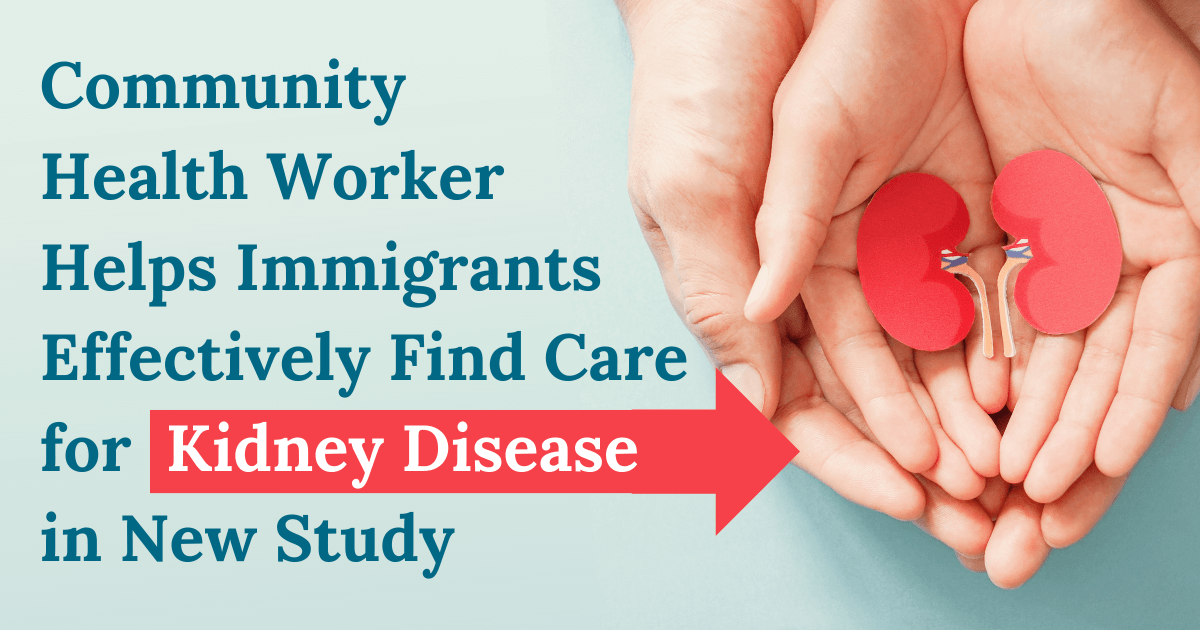Community Health Worker Helps Immigrants Effectively Find Care for Kidney Disease in New Study

Why do Latinxs in the United States have a higher risk of kidney failure? The risk of kidney disease among the US Latinx population is the same as in the US white population, “but, their disease is more likely to progress into kidney failure. They’re more likely to end up on dialysis," said Tessa Novick, MD, a nephrologist Assistant Professor of Nephrology at Dell Medical School at The University of Texas at Austin. Numerous barriers like language, a lack of insurance, and unfamiliarity with the US medical system are preventing Latinxs with kidney disease from accessing the care they need; consequently, their disease may progress faster and more frequently to kidney failure compared to their white counterparts. Dr. Novick’s new study, published in the journal Kidney Medicine, shows that a Community Health Worker (CHW) intervention can remove those barriers and get people who need kidney care into treatment.
The study enrolled its participants at health fairs at the Ventanilla de Salud (VdS) in Austin, Texas. VdS is a network of health outreach programs housed in each of the Mexican Consulates in the US. (Migrant Clinicians Network is the fiscal agent for the VdS in Austin.) At two recent fairs, Dr. Novick and her team evaluated the body mass index, blood pressure, and albumin readings of interested fairgoers to find eligible participants. Albumin, a protein detectable in urine, is a marker for kidney damage.
Then, Dr. Novick went over the results individually with participants, explaining what the results mean, and inviting eligible participants – those with high BMI, high blood pressure, and/or high albumin readings – to join the study. “The CHW was there at the screening. I said, ‘If you’re interested, this gal can help you get connected to care and find a primary care doctor that’s close to you,” Dr. Novick said. Of those enrolled in the intervention, 41% had albumin readings of above 30, indicating some level of kidney damage. Three people had readings above 300. “That was pretty alarming, although it’s pretty much reflective of the nationwide statistics,” Dr. Novick noted. “All of these individuals were unaware of kidney problems.”
In total, 49 people enrolled and 20 of those enrollees completed the intervention. “We lost contact with a lot of people,” Dr. Novick admitted. Barriers to follow up, like shared cell phones, are detailed in the study with suggestions for solutions to those barriers.
Those who did complete the intervention were assisted directly by the CHW to sign up for insurance for which they’re eligible, connect with primary care, and begin to address their health to reduce their risk of advancing to kidney failure. There are insurance options in counties and cities in Texas, like in Austin, that many people in the intervention didn’t know existed, or believed wasn’t available to them, Dr. Novick noted. They also didn’t realize they had risk factors for kidney disease. “Obviously, there’s dehydration and heat injury – but also, the working conditions [that many people in the intervention experience] are not conducive to a healthy diet,” she said. For example, when she asks a middle-aged male construction worker if he’s eating vegetables, she gets blank responses. A healthy plant-based diet is part of the educational component in the intervention, as more research confirms that a plant-based diet may slow progression toward kidney failure and a host of other health issues, Dr. Novick said. Many low-wage Latinx workers do not have easy access to whole plant foods, opting for cheaper and more readily available premade products at convenience stores or fast food restaurants.
Education was a critical aspect of the intervention, “taking the time to arm people with knowledge on kidney disease, on the risks associated with high blood pressure,” and the risks associated with doing nothing, she said. “Providing education is just so powerful, since they don’t have the same opportunity and access to medication.” Additionally, she noted, educated participants become advocates in their own families and communities, sharing stories, warning signs, and risk factors with others.
In addition to the educational aspect, Dr. Novick believes the intervention was successful because of the integration of a CHW, and the location of the enrollment at the VdS – both of which are critical for trust.
“What we’ve found from participants is they won’t go to a place they don’t trust, and the VdS is a place they trust,” Dr. Novick noted. “It’s critical to partner with the Consulate to engage people.”
Read the article, Facilitating Medical Care for Latinx Individuals at Risk for CKD: A Pilot Intervention, in the journal Kidney Medicine.
Learn about weekly Friday health fairs at the Austin Ventanilla de Salud, which often include kidney screenings provided by the National Kidney Foundation, on the Austin VdS Facebook page.
- Log in to post comments